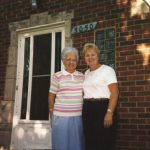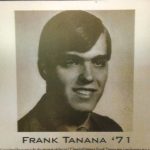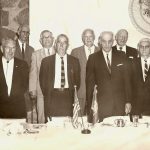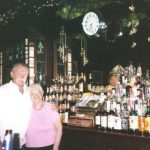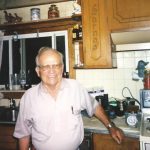 West Side Detroit Polish American Historical Society
West Side Detroit Polish American Historical Society
Interview with Edward J. Sarna (“ES”), Detroit, MI 48210
June 27, 2007
[Looking at photographs of when Edward Sarna was in Children’s Hospital in Farmington Hills as a child, with tuberculosis of the spine; talking about the woman who would later become his wife.]ES: That’s where I met her because her brother had polio. And I met her through him because after that, my mother and her mother used to work at Hygrade’s together. And Hygrade’s was down where the expressway goes over Michigan Avenue.
INTERVIEWER: I’ll just start this interview by saying we’re here with Edward J. Sarna, and the “J” stands for-
ES: John.
INTERVIEWER: John, I knew that. And this is June 27, 2007, and we’re at Mr. Sarna’s home at 4674 52nd Street, Detroit 48210. And Mr. Sarna is giving us information for our archives at the West Side Detroit Polish American Historical Society. Mr. Sarna is a remarkable survivor of tuberculosis of the spine, which they discovered when he was just three years old back in the year 1932.
ES: The photographer was a buddy of mine. I wish we would have had some movies of the wedding. I’ve got about two minutes of the wedding.
INTERVIEWER: You have some footage?
ES: Yeah. I’ve got it on DVD now. I took all my home movies and put them on DVD. I had the 8-mm. camera, and from 8-mm. I put it on VCR, and from VCR, I put it on DVD.
INTERVIEWER: Your kids are going to thank you, and your grandkids. And your wife’s maiden name was?
ES: Julia Pieknik.
INTERVIEWER: How do you spell that?
ES: P-I-E-K-N-I-K.
INTERVIEWER: And when were you married?
ES: April 21, 1951.
INTERVIEWER: And you were born on what date?
ES: 6/15/29.
INTERVIEWER: You just had a birthday. And what were your parents’ names?
ES: Mary and Jacob.
INTERVIEWER: Your mother’s maiden name was?
ES: Kapicaz. K-A-P-I-C-A-Z. I just found out there’s a “Z” after the “A.”
INTERVIEWER: Do you know where they were from originally in Poland?
ES: My sister’s got that information. I’ll get it. We’ve got her papers from when she came over on the ship.
INTERVIEWER: And your father immigrated also?
ES: Yeah.
INTERVIEWER: Do you know about when they came over?
ES: I think my mother came over in 1913.
INTERVIEWER: And did they settle in this neighborhood?
ES: In this area, yes, on the west side.
INTERVIEWER: And your father immigrated about when?
ES: I couldn’t really tell you.
INTERVIEWER: And what did your father do?
ES: He worked at Ford. He had black lung disease and he died just before I went into the hospital in 1932.
INTERVIEWER: So he worked in assembly?
ES: No, he worked in the foundry. And my mother’s first husband was killed on Grand River. His name was Golumb.
INTERVIEWER: How do you spell that?
ES: I’m not sure. G-O-L-U-M-B, I believe it is.
INTERVIEWER: And how many brothers and sisters do you have?
ES: I only have one real sister. I had two step-brothers and one step-sister. But they’re all deceased.
INTERVIEWER: What was your sister’s name?
ES: Which one?
INTERVIEWER: Your full sister.
ES: My full sister is Virginia.
INTERVIEWER: Do you know what year she was born?
ES: Yeah, March 25, 1927. (Continuing to look at Mr. Sarna’s wedding photo album.) So I was saying that my cousin made that cake. He went to Chadsey in the baking school. Then he opened the place in Standish.
INTERVIEWER: They had a baking school at Chadsey?
ES: Oh, yeah. They had a big food-they were noted for their food.
INTERVIEWER: Chadsey High?
ES: Yeah.
INTERVIEWER: And your wedding date again was?
ES: April 21, 1951.
INTERVIEWER: Do you remember the name of the woman who made your wife’s gown?
ES: No, I don’t.
INTERVIEWER: But she had a shop?
ES: On Junction, right across from St. Hedwig.
INTERVIEWER: I’ll bet we could find it in some of our old programs. I brought-
ES: Yeah. It wasn’t too far from where Pienkos and [inaudible], you know where the funeral home was?
INTERVIEWER: Yeah. I brought these for you to look through later. These are some Laur programs from the ’40s. They’re just loaded with ads for a whole bunch of the west side establishments. Maybe we can even find that woman’s shop in here. One of the things our society is doing is putting together a list of the west side businesses for publication. (Looking at funeral home statement from Mr. Sarna’s father’s funeral.) At the time he was living at 4840 Proctor?
ES: Yeah.
INTERVIEWER: Joseph J. Sarnowski, Funeral Director, at 4188 Campbell Avenue, corner of Buchanan, Lafayette 5963-64. December 27, 1932. The total funeral-
ES: He died on Christmas Day.
INTERVIEWER: Oh, passed away on Christmas Day, 1932. The total funeral expenses, $522.00.
ES: That’s including the two graves.
INTERVIEWER: That’s including the two graves. Cemetery expenses $10.00, embalming $20.00, casket $275.00, box $10.00, hearse $12.00, limousine $20.00, suit $16.50. He provided the suit?
ES: Yeah, I guess so.
INTERVIEWER: Gloves? $2.00? They put gloves on him? The two graves $120.00, cemetery $10.00, “palmas” $10.00, embalming $20.00, candles $4.00, services $15.00, door bage-it says door bage $8.00.
ES: That was probably, you know, they used to put flowers on the doors, you know, bages, you know, they didn’t have them all the time in the funeral home. They would have a flower arrangement on the door.
INTERVIEWER: I see.
ES: If you want a copy of that, I’ll run a copy for you.
INTERVIEWER: Yeah, I’d love to have a copy of that for our archives. So your wedding reception took place where?
ES: Well, we got married at Our Lady Queen of Angels. We were the last wedding in the old church.
INTERVIEWER: Oh. And the reception was at the-
ES: I forget the name of the hall. It was at-
INTERVIEWER: Do you know how many people you had at your reception, about?
ES: I think we had like about 150 couples.
INTERVIEWER: That was a big wedding. That was about average back then.
ES: Yeah. But like I was telling you, the day of the wedding, we had the street car strike.
INTERVIEWER: [Laughter]
ES: And a lot of the people didn’t have cars, so we had to go pick them up so they could go to the wedding. And they messed up on the church. We were supposed to have ten o’clock mass, they had us down for eight o’clock mass or something. We had to notify all the people, and the people that had-they changed us. You know, she was good enough to– We told them we’d buy all the flowers for the church because at that time, you know, you bought all the flowers and everything. We said we’d pay for all the expense of the flowers. We already went out once to tell them about the hall being exchanged. [Laughter] Because two weeks ahead of the wedding, they told us we didn’t have the hall. We were going to sue them, but one of the councilwomen or councilmen had something to do with that Gilbert Hall, and so they told us we couldn’t sue them anyway. So, like I said, in two weeks’ time we had to find a new hall, we had to notify all the people, we had all the invitations sent out. Yeah, and like I said, on top of all that, the day of the wedding they had the streetcar strike.
INTERVIEWER: You know it seems like everybody has a story like that. Well, not quite as bad as yours, I have to admit, but one lady was telling me about her cook somehow fell through so she was driving around buying all the chickens, and bringing the chickens back and her dad was chopping the heads off the chickens in the kitchen while she was trying to get ready for her wedding.
ES: That’s like us. I mean, the cook-my mother-in-law wanted to cook because it was a relative. This cook never cooked for a big wedding. She didn’t buy enough food so the day of the wedding we had to go out and buy some more food. My wife’s grandfather was in the kitchen peeling potatoes all day long. [Laughter] Because, you know, at that time, they had the breakfast and you had the evening.
INTERVIEWER: Two meals.
ES: Two meals, right. And so we had a mess, I mean.
INTERVIEWER: But it all worked out, didn’t it?
ES: Yeah, it worked out.
INTERVIEWER: And you had that to talk about for the rest of your days.
ES: That’s my mother. Okay, this is her brother that was in the hospital with me. He had polio. He’s dead now, too. And this is her mother and father. And this is her little brother. He was a ring bearer.
INTERVIEWER: So he’s how you met your wife? [Referring to Mr. Sarna’s brother-in-law.]
ES: Yeah.
INTERVIEWER: Did he pass away at a young age because of the polio?
ES: Yeah, he was only, I’d say around fifty-some or just early sixties.
INTERVIEWER: What does the SWH stand for?
ES: That’s what I’m saying, it was South West something.
INTERVIEWER: Oh, South West Hall.
ES: Maybe South West Hall.
INTERVIEWER: So it wasn’t the high school?
ES: No, no, no.
INTERVIEWER: It was a hall.
ES: It was a hall, yeah.
INTERVIEWER: I see. They had a nice stage. Nice backdrop.
ES: It was a smaller hall, though, I mean. Gilbert Hall was a big hall. That’s where you talked about everybody takes the veil off, and all the bridesmaids dance with it on for a while.
INTERVIEWER: I wish I’d known about these photos when I did the film. We could have had you as a star in the film.
ES: And this is her sister. She’s living in Canada now. This is the cake.
INTERVIEWER: He was proud of that cake, I know. That was a gorgeous cake.
ES: Yeah. And, like I said, he-it was funny, you know, he took up baking and everything, and then after he opened a restaurant in Standish, then he got allergic to flour and couldn’t bake anymore.
INTERVIEWER: Probably from working with it for so long.
ES: Those were our flowers.
INTERVIEWER: Those were beautiful. Now, where would you buy your clothing back then? Like your suit, where would that have come from?
ES: I think they had Sam Leight or something.
INTERVIEWER: Yeah, I saw that, ads for that in one of those brochures. It was Leight, wasn’t it?
ES: I don’t know what-it was similar to that, yeah.
INTERVIEWER: You had professional photographers for the showers?
ES: No, it was just my buddy. He wasn’t really a professional.
INTERVIEWER: Oh. You had the photos enlarged. Very nice.
ES: He did all of his own developing and everything.
INTERVIEWER: And where was the shower held?
ES: On Gilbert.
INTERVIEWER: You don’t remember what the hall was called, or where the hall was?
ES: No, I could pick it out.
INTERVIEWER: It’s still there, you think?
ES: Yeah.
INTERVIEWER: Really?
ES: I mean, it’s not a hall anymore.
INTERVIEWER: The building’s there, though, right?
ES: Yeah.
INTERVIEWER: We should drive by it. I wonder who’s in these photos.
ES: I don’t know.
INTERVIEWER: This is an amazing photo. Beautiful pictures. Oh, you have a second album.
ES: Yeah. We can look at that.
INTERVIEWER: This would be at your wife’s home?
ES: Yeah.
INTERVIEWER: Look at all those attendants. Seven attendants and a flower girl. She could be an attendant. She looks young, though.
ES: Yeah, she’s a flower girl.
INTERVIEWER: Yeah, she looks like a little doll.
ES: That’s her mother and that’s my mother.
INTERVIEWER: She’s doing the blessing.
ES: Yeah.
INTERVIEWER: I wish I’d had a picture of that for the film. I have not seen a picture of that yet. That’s historic. That one’s very historic. And there she is coming out of the house.
ES: See, now, I can’t see Clarence [Witkowski]. I mean, there’s part of his band, but you know, he must be behind the bride.
INTERVIEWER: These are awesome photos. Awesome photos. They’re looking at the train. That’s a long train. There’s the church. That was my dad’s church. I think I told you that. Now, were all these bridesmaid’s gowns handmade, too, or did they buy them at a shop?
ES: No, I think she made all the gowns.
INTERVIEWER: That was the happiest day of your life, wasn’t it?
ES: Um-hum. This is coming into the hall, like you have it in the film.
INTERVIEWER: Oh, look at that. Now, did she graduate from-
ES: St. Hedwig’s. And this is the last picture. Our fiftieth anniversary. From St. Hedwig’s.
INTERVIEWER: Now I have to get the story of your hospitalization on tape.
ES: That’s when she became a citizen, my mother.
INTERVIEWER: Oh. She was born on August 28, 1892.
ES: That’s wrong.
INTERVIEWER: Oh, that’s wrong?
ES: Yeah. It was the right year, but the wrong date. She was born on October 28. You can have all these.
INTERVIEWER: Thank you very much. These are for our archives.
ES: [Looking at year book from Chadsey High School] Here’s a Claudia Witkowski. I don’t know if she’s related to Clarence Witkowski or not. I know he graduated in ’49.
INTERVIEWER: I know he has a sister, but I don’t think her name is Claudia. She was blonde. And she was a singer.
ES: His sister married the guy who used to own the 52nd Show Bar. Here’s a William Witkowski.
INTERVIEWER: I know he’s got a brother, too.
ES: I don’t know why I never got a ’49 book. We had a class reunion, and we had ’48, ’49.
INTERVIEWER: So, now we’re going to get the story of your remarkable, miraculous recovery from T.B. Do you-How did they discover that you had T.B.?
ES: My mother took me to a chiropractor and he was doing a lot of good with me, but he passed away and then, you know, she had nobody else, and then this-I don’t know the whole story how she might have-But I guess what happened, from what I gather, that when I was a baby, I fell off the bed and hit the corner of the chair. My back hit the corner of the chair. And somehow, you know, that-
INTERVIEWER: The trauma?
ES: Yeah.
INTERVIEWER: But could that have caused the T.B.?
ES: I don’t know, really. But that’s-
INTERVIEWER: It was a weak point in your back, maybe?
ES: Yeah, it must be.
INTERVIEWER: So then you needed to go into the hospital.
ES: Yeah. Like I say, I don’t remember much when I was younger.
INTERVIEWER: So you were just three years old. And in this photo, would this have been right-
ES: About the same time.
INTERVIEWER: About 1936.
ES: Yeah.
INTERVIEWER: And this hospital was Children’s Hospital, and it was right across the street from Botsford Inn?
ES: Botsford Inn now.
INTERVIEWER: On Grand River.
ES: It’s torn down now, I guess.
INTERVIEWER: Oh. Yeah, the hospital is. [ NOTE FROM INTERVIEWER: It has since been confirmed that Children’s Hospital was then located on Folsom Road, east of Orchard Lake Road, in Farmington Hills, on the site of what is now the Botsford Commons Rehabilitation and Nursing Home.]
And you’re on a brace.
ES: I’m on a frame-
INTERVIEWER: A frame.
ES: –that’s curved either concave or, what do you call that?
INTERVIEWER: Convex.
ES: Convex, yeah.
INTERVIEWER: To-
ES: And that’s the way I had to sleep and everything.
INTERVIEWER: So they obviously had to make this frame for you for your back. And your mother came every day?
ES: No, just once a week.
INTERVIEWER: Once a week. And she took the streetcar or the bus?
ES: Well, she took the bus up to Eight Mile and Grand River, and then she had to walk the rest of the way because they had no bus service further out.
INTERVIEWER: Do you recall-I mean, you were in this position for eight years.
ES: Well, I was in there for about six and a half years before they operated on me.
INTERVIEWER: Do you remember?
ES: I don’t remember, no.
INTERVIEWER: You don’t remember?
ES: Like I say, the only thing I remember, I remember I used to be an expert at the paddle ball. Because, you know, I just laid on the god-darned thing and pounded that thing up and down. And I remember when I used to drink water, I mean, I’d take the drink and I’d hold it way up there and have it just pour down. I can remember that much. Then I remember the only thing I really liked, I used to like onion sandwiches. We used to have green beans and onions.
INTERVIEWER: [Laughter]
ES: And I used to take the onions out of the green beans and put them on the bread. And so after that, every night they used to give me an onion sandwich. But, I mean, that’s about more or less what I can remember. And the only thing, you know, I went to-I was in the hospital with a William Dwyer, and I called William up because he’s the police chief in Farmington Hills. But he never called me back to see if he’s the one. So I don’t know if he was the one or not. And they used to live on Forrer. I don’t know if they were a relative of the one that I was in the hospital with or what it was. But I was hoping that he would call me back.
INTERVIEWER: Well, my husband and I are block captains of the Neighborhood Watch in Farmington. We know our Farmington police chief. I’m going to see if he can put a call in and see if he can get an answer for you. [NOTE: It has since been confirmed that Farmington Police Chief William Dwyer is not the man who was in the hospital with Mr. Sarna, nor does he know of any relatives who were.]
ES: Like I said, I can remember going over to his house. They used to live on Forrer Street in Detroit. Not too far off Grand River Avenue.
INTERVIEWER: Did you have visitors, like volunteers, coming to cheer you up?
ES: No, the only-my brother used to come down there. The most people I can remember is my cousin because he always was telling jokes and stuff like that. I always called him Funny John.
INTERVIEWER: What was his last name?
ES: Duscinski (ph).
INTERVIEWER: How do you spell that?
ES: I don’t know how to spell it.
INTERVIEWER: So as you grew, obviously they had to adopt the brace to fit.
ES: Yeah, I had a brace for a long time after I’d been out of the hospital. I’ve still got it someplace around here.
INTERVIEWER: So then, when they operated, they took a bone out of your leg, your left leg?
ES: And transferred it into my back. I don’t know, you know, it was probably pieces of bone. But I got a stiff back, you know, I can’t bend my back just like a normal person can.
INTERVIEWER: Yeah. And they predicted that you-
ES: Would never walk.
INTERVIEWER: –would never walk.
ES: So when I came home, my mother used to have to more or less carry me around.
INTERVIEWER: And you were how old when you came home?
ES: Eleven.
INTERVIEWER: Do you remember how long it took for you to get up on your feet?
ES: I don’t remember that. Like I say, it wasn’t too-I mean, I could walk, but I couldn’t walk far. And I lived on Otis, which is not too far from Michigan and Junction, and I remember the five-and-dime store there, Woolworth’s, Kinsel’s, Cunningham Drug Store, right on the corner.
INTERVIEWER: And, of course, somebody came from church because you made your first Holy Communion in that position.
ES: Yeah, I think they had church every weekend.
INTERVIEWER: I know you showed me a picture of that. Where was that?
ES: It’s the next picture.
INTERVIEWER: This is your first Holy Communion. It’s absolutely miraculous.
ES: Um-hum. And from my operation I came out strong.
INTERVIEWER: I mean, I wonder-I don’t think that the medical community does much of this.
ES: No.
INTERVIEWER: And I wouldn’t think that they had done much of this back then, either. It just seems like such a miracle.
ES: Well, like I said, they never run into this case before, more or less, and, you know, I was just experimental, you know. And, like I say, when they operated they told my mother they’d try, but they never figured I would walk, you know.
INTERVIEWER: Now, what line of work did you go into?
ES: I went into the electrical motor repair, Spaulding Electric. And then after a while I ran their shop almost.
INTERVIEWER: Where was that located?
ES: 1350 Michigan Avenue. My daughter works there now.
INTERVIEWER: Obviously you were never able to serve in the armed forces.
ES: No. They kicked me out.
INTERVIEWER: Oh, did they draft you?
ES: Yeah.
INTERVIEWER: They drafted you?
ES: Yeah. But you know the funny thing is, it was just before my wedding, and I did not want to go in. It was about a year before my wedding and we had the hall planned and everything else. So I was telling them I had a bad back, and they just kept me-at that time, when there was a war on, they kept pushing you through the line. And it was funny. They gave me a dishonorable discharge on account of my ear, not my back. [Laughter] And I didn’t know I had anything wrong with my ear, but I guess I must have a busted eardrum or something, you know.
INTERVIEWER: Why would that be a dishonorable discharge?
ES: I don’t know. I mean, it wasn’t dishonorable, but I was classified 4F.
INTERVIEWER: Okay.
ES: Yeah. Because I never went in. At the time I was glad not to go in.
INTERVIEWER: I was going to say, yeah. It was a good thing you didn’t have to go in.
ES: But, and if I did go in, I wanted to be a tail gunner because that was a, you know, a small person had to be a tail gunner. You had to be small. I figured if I did go in, that’s what I would ask for.
INTERVIEWER: What does the tail gunner do?
ES: Oh, that’s where in the bombers, and they used to sit in the back there, with their guns out in the back there, and they used to shoot the planes that were coming towards the rear. Those were on the big bombers.
INTERVIEWER: I’m glad you didn’t end up doing that.
ES: Yeah.
INTERVIEWER: So how many years did you work?
ES: I worked from 1951 until 19-forty-three years, I guess.
INTERVIEWER: Do you think that faith had a lot to do with your recovery from your–?
ES: Well, if it was, it was probably my mother’s faith. She worked all her life. Actually, she never did pay the whole hospital bill. Our lawyer went over and talked with one of the congressmen or something and they dropped the bill after a while.
INTERVIEWER: What did your mother do?
ES: She worked at Hygrade’s. She used to cut meat.
INTERVIEWER: Oh, yeah.
ES: Yeah. It was hard work. And then we went on vacation and went to New Jersey, and when she come home, she found out she was laid off. What they did, they laid all the old people off because that’s when the union started coming in. They didn’t want to give no benefits or nothing. And, you know, like I say, she never collected a cent in unemployment or nothing. She was too proud, you know. That’s what gets me, I mean. The old people that came here, I mean, they didn’t go on with all this, you know. Now, if you don’t give it to them, I mean-
INTERVIEWER: Do you remember who your lawyer was?
ES: Lubinski.
INTERVIEWER: Lubinski. Do you think he’s still alive?
ES: No, he’s dead. But his-he’s got two sons that took over. They were on Warren and Southfield. You know, that office is closed, but they do have a place on Ford Road, I guess. On Lubinski was, I think, went into a judge after a while. When we bought the house, you know, he was the one that took-but, like I say, he was right next to Dom Polski. His office was right on Junction there.
